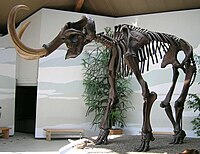
Photo from wikipedia
The pharmacodynamic profile of antimicrobial peptides (AMPs) and their in vivo synergy are two factors that are thought to restrict resistance evolution and ensure their conservation. The frog Rana temporaria… Click to show full abstract
The pharmacodynamic profile of antimicrobial peptides (AMPs) and their in vivo synergy are two factors that are thought to restrict resistance evolution and ensure their conservation. The frog Rana temporaria secretes a family of closely related AMPs, temporins A-L, as an effective chemical dermal defence. The antibacterial potency of temporin L has been shown to increase synergistically in combination with both temporins B and A but this is modest. Here we show that the less potent temporin B enhances the cooperativity of the in vitro antibacterial activity of the more potent temporin L against EMRSA-15 and that this may be associated with an altered interaction with the bacterial plasma membrane, a feature critical for the antibacterial activity of most AMPs. Addition of buforin II, a histone H2A fragment, can further increase the cooperativity. Molecular dynamics simulations indicate temporins B and L readily form hetero-oligomers in models of Gram-positive bacterial plasma membranes. Patch-clamp studies show transmembrane ion conductance is triggered with lower amounts of both peptides and more quickly, when used in combination, but conductance is of a lower amplitude and pores are smaller. Temporin B may therefore act by forming temporin L/B hetero-oligomers that are more effective than temporin L homo-oligomers at bacterial killing and/or by reducing the probability of the latter forming until a threshold concentration is reached. Exploration of the mechanism of synergy between AMPs isolated from the same organism may therefore yield antibiotic combinations with advantageous pharmacodynamic properties.
Journal Title: Biochemistry
Year Published: 2022
Link to full text (if available)
Share on Social Media: Sign Up to like & get
recommendations!